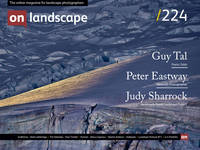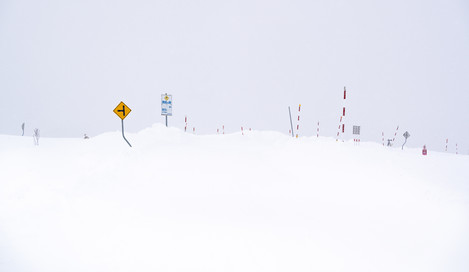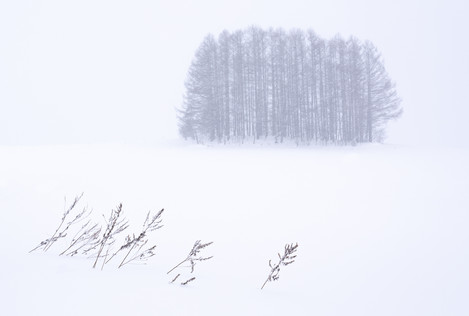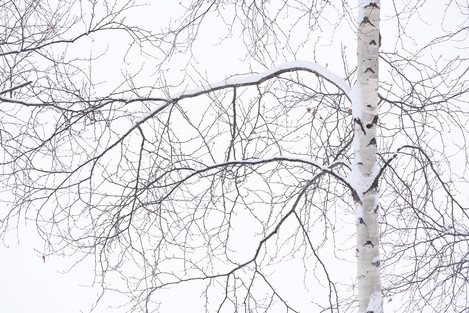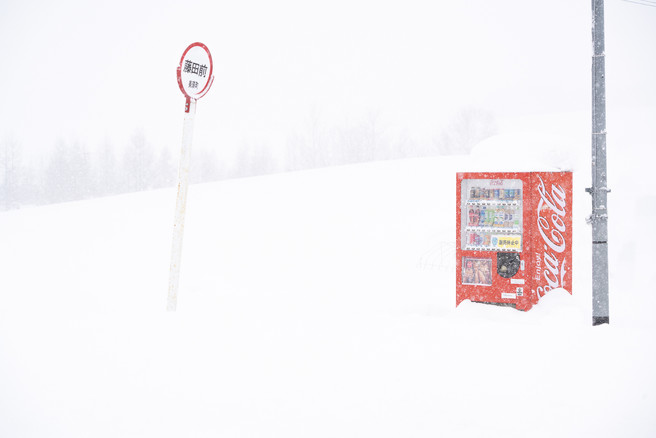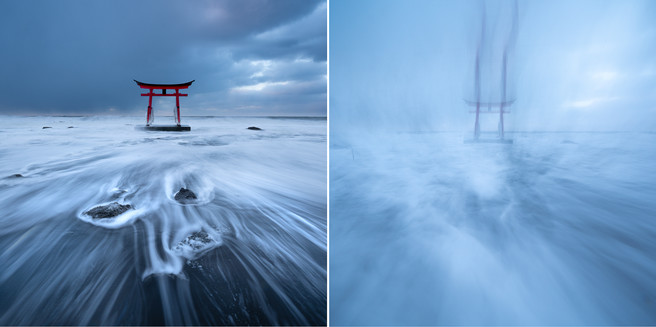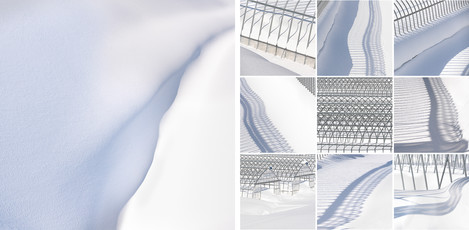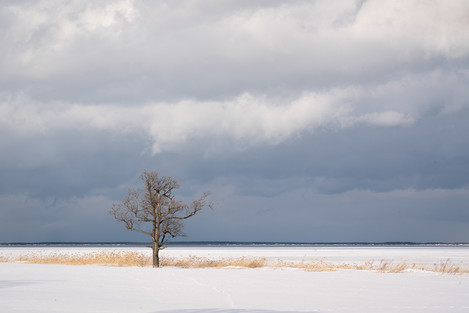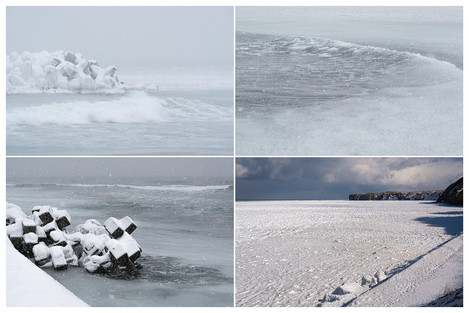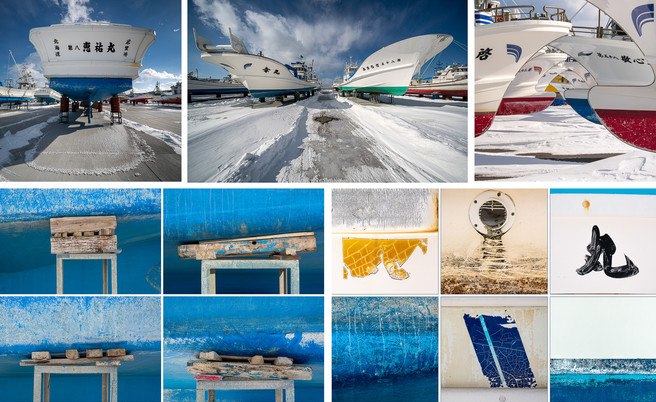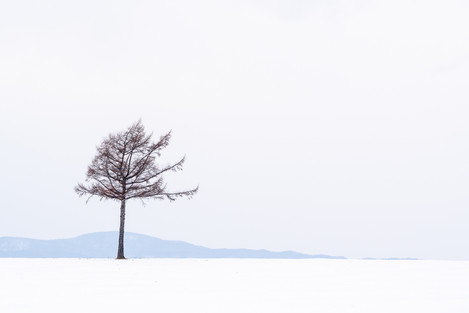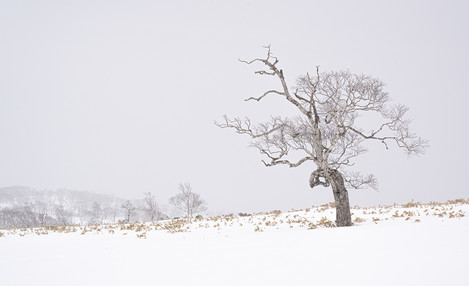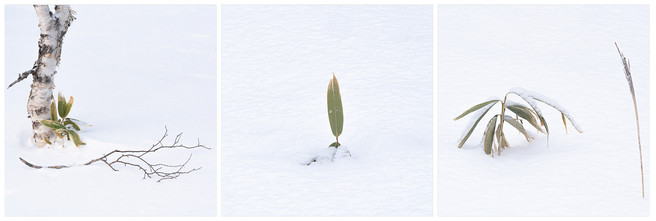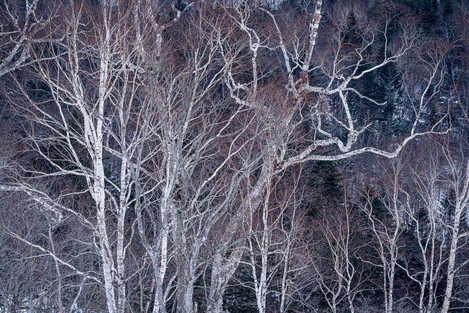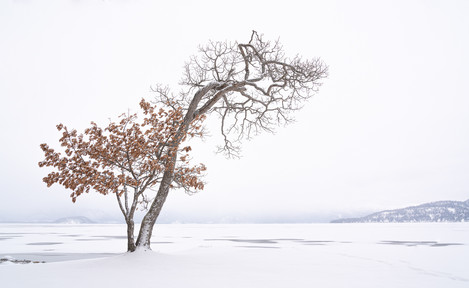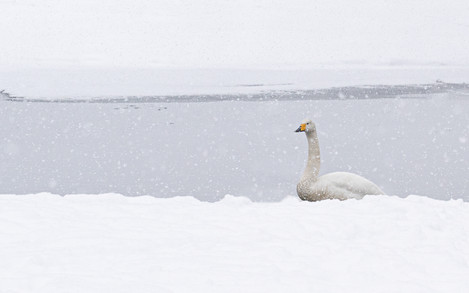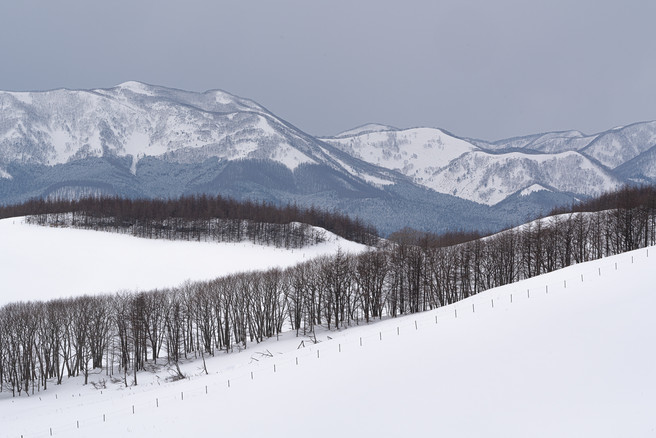Simplicity & beauty of line & form

Martin Addison
Photography has played an important part in my life ever since I was a teenager and I have been an active member of the Worcestershire Camera Club for over 40 years. I have photographed without a break ever since and am still as enthusiastic as when I started.
I have lectured at camera clubs since 1979 in audio visual, slides, Cibachrome colour prints, digital prints and projected images. I have had four books published by Focal Press on Corel Painter for Photographers. In 1994 I was awarded a Fellowship of the Royal Photographic Society and am now a panel member for the Visual Art category.
I have never considered myself as a landscape photographer, more of a creative photographer who enjoys many subjects; in particular abstracts and departures from reality using techniques such as multiple exposure and camera movement.
I first became aware of Hokkaido when I saw an article by Paul Gallagher saying how much he had enjoyed his visit and how different the landscape was to what he was used to. I loved the simplicity of the images in the article, so when some months later I saw that he was arranging a workshop in Hokkaido I jumped at the chance to visit.
I do very little planning for a trip like this beyond arranging flights, clothing etc, partly because with a workshop I expect to be taken to interesting places, but equally because I like to arrive at a location with an open mind and react to the landscape in my own way. If I were to study photographs by other people, I might go with preconceived ideas of what to expect and I don’t like that, I want to make my own images in my own way. If I miss classic views (which I often do) that is fine as I will have found my own interpretation of the place which will mean much more to me.
The workshop
The workshop was in early February 2019 and I decided to add on a few days in Tokyo first, partly to recover from any jetlag but also to explore a city and country I had not previously visited. This was a good decision and I enjoyed the days wandering around various areas of the city and the bustle of this great city proved to be a huge contrast to the silence of Hokkaido.
Hokkaido is the most Northern island of Japan and is full of flowers in summer and a popular place for Japanese tourists, but in February it is in the grip of winter and usually with deep snow.
The flight from Tokyo to Asahikawa airport in Hokkaido took about 95 minutes and there were warnings that we might not be able to land there due to heavy snow. We landed OK and I was delighted to see lots of snow, quite a change from mild Tokyo. At lunchtime next day I met the rest of the small group plus our guides Paul Gallagher and Michael Pilkington and our local guide Tsuyoshi Kato.
We started our trip in the Biei area and we stopped at the Seven Star Tree. This lone Oak tree became an overnight sensation for its use on a package of Seven Star cigarettes in 1976 and I was very surprised to find several coaches of Japanese tourists there. Fortunately, they alighted from the coaches, took selfies with the tree and left again soon afterwards. I hadn’t expected to see lots of other people on this trip and fortunately, this was a rare exception.
This stop gave me a taste of the weather to come, overcast with regular snowstorms. I loved the snow as it gave a great texture to the trees and landscape, although it made photography difficult when it was blowing straight into the lens.
Having photographed the Oak tree and the adjacent line of trees, I looked around to find something which interested me more and I discovered lots of snow poles and signs in the deep snow which I really enjoyed exploring. Look closely and you will see a lone tripod and camera, but no sign of a photographer! I didn’t spot that until I got home.
Trees were undoubtedly the principal subject of the trip; they were everywhere and the deep snow gave them a simplicity which rendered them very beautiful and special. Although I enjoyed the shots I took of the tree copse, I felt that the foreground grasses added a lot to the composition. The almost horizontal snow in this photograph added to the separation between the foreground and trees.
We stopped at a frozen lake where I was particularly attracted to the view across the lake to trees covered in frost and snow. A long lens made some very abstract images. I particularly liked this elegant tree with the white background and the snow on the branches adding to the image.
On several occasions, we saw Coca-Cola dispensers, deep in the snow. They seemed to be full of cans which was surprising as I would have thought that the cans would all be frozen. The juxtaposition of the dispenser and the sign made the image work.
We travelled to the North West coast and as the sun was going down, we photographed a Torii Gate in the sea near our hotel. The snow was deep by the shore and there was not much room at the water’s edge.
The first photograph was taken just before the big wave and the other exposed as the camera sank in the water A ‘UCM’ - unintentional camera movement.
We travelled to the North East coast, stopping a few times, including some greenhouses with just the structures visible. These were great for picking out patterns and details. We had very little sunshine during the trip, which suited me very well as I like overcast conditions, but here the sun did come out which was fortuitous as the shadows enhanced the patterns.
The snow was immaculate most of the time and I enjoyed making very simple compositions with shadows.
Details of simple plants in the snow kept me occupied in many places, looking for compositions which pleased me.
A 400mm lens was used for these details, I use Sony cameras and took two A7r3 bodies, a 12-24mm, 24-105mm and 100-400mm, all Sony lenses. Lightroom shows that the 100-400mm was my most used lens (56%) followed by the 24-105mm. I also used a Gitzo tripod with a geared head for all the images.
This stop by one of the many frozen lakes was memorable for the rich colours of the grasses which contrasted well with the colours in the sky. The snow was very deep here and I remember struggling across this field in snow which was waist high in order to make the most of the grasses. The trip was very tiring as everything was hard work, from getting dressed in all the layers in the morning to being outside in the cold. Fortunately, we were not out for long periods of time and could relax when back in the minibus.
Photographing on the East coast of Hokkaido we encountered wet snow for the first and only time on the trip. The temperature had obviously risen above freezing and the snow was more like we normally get in the UK and we had to protect our cameras to keep them from getting very wet. The rest of the time we could just brush off the snow with no problem.
In the photograph bottom right, the sea was freezing and had created a slowly moving slush. This was a bitterly cold morning as the wind was very strong and the wind-chill factor made it feel much colder.
As the sea freezes over the fishing boats in this area are raised out of the water onto land for the winter providing a good subject both for a wide-angle lens and also for close up details.
I was fascinated by the wooden blocks which supported the boats, I am sure that they were very secure, but I felt that one push would collapse the whole line of them. I was very careful!
Returning to trees again the distant hills provided the perfect background for this elegant tree. For me, this image encapsulates the feelings I had for Hokkaido, clean lines, elegant trees and simplicity. There were many trees here and many opportunities for different compositions with two, three or more trees in the foreground and that delicate blue line of the hills in the background.
One of my very favourite locations was a hillside with lots of interesting trees; this was a delight. We had many short snowstorms which kept everything fresh and we spent several hours here exploring different compositions of trees, snow and the bamboo which grew close to the ground.
I found the bamboo leaves peeking through the snow quite irresistible. A long lens is a real help here to avoid walking through the snow too much. When the snow covers everything, it is hard to tell where you are walking and most of Hokkaido is private farmland so we were careful not to trespass, well not too much anyway.
These lovely trees were in the shade of a hillside and they looked almost like negatives against the dark background and I loved the colours in this image. Most of the photographs I created in Hokkaido were very simple designs and this is one of the few more complex compositions.
I am very much a colour photographer and rarely create black and white images and throughout my trip to Hokkaido I appreciated the limited colour palette in the landscape.
We visited several frozen lakes where I loved the rich colours of the leaves and grasses which contrasted beautifully with the frozen white background of the lake. There were many subjects to photograph here; the patterns in the lake were lovely as were the distant hills which quite often looked like pencil drawings.
We spent an early morning here to try and capture the sun and mist rising across the lake, but had only cloud, which suited me as I usually prefer the subtle colours of dull weather to a spectacular sunrise.
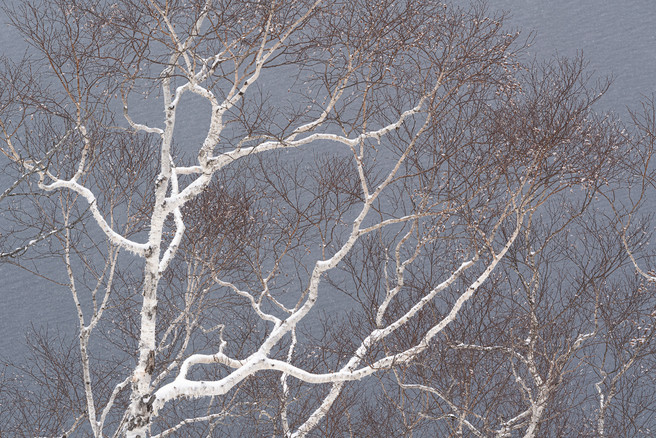
Looking over another frozen lake the white trunk and branches of these Birch trees were beautiful and quite startling against the darker background. It was snowing when I took this photograph and this added a white layer on the branches and a subtle texture to the background.
There are many Whooper swans that live on this lake throughout the winter and they return to Siberia in Spring to breed. I am not a wildlife photographer, but I took a few shots here and enjoyed the empty lake and the birds in the snow.
Later we also visited the famous Hokkaido Cranes, but I was put off by the large crowd of Japanese photographers who were pushing to get shots of the birds; not my sort of photography.
This is a typical view of Hokkaido, fences and lines of trees which make such great compositions. The beautiful blue hills in the background partially covered with trees together with a plain sky and areas of white snow complete the scene.
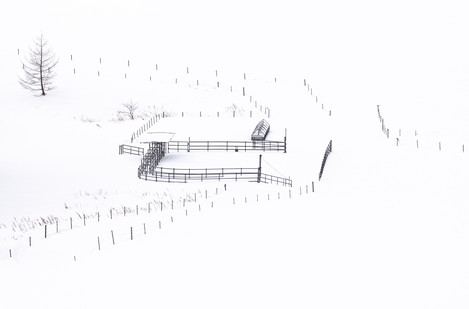 My abiding impression of Hokkaido was of simplicity and beauty of line and form, which of course are important elements of Japanese art and this picture perhaps illustrates this very well; nothing special, just farmland with fences and a tree. There is no need for a spectacular view, no need for special lighting, I am happy to create photographs from very simple elements.
My abiding impression of Hokkaido was of simplicity and beauty of line and form, which of course are important elements of Japanese art and this picture perhaps illustrates this very well; nothing special, just farmland with fences and a tree. There is no need for a spectacular view, no need for special lighting, I am happy to create photographs from very simple elements.
This was a memorable trip and I am delighted with the photographs I was able to make there.
You can view more photographs from Hokkaido on my website; there is also an audio-visual sequence from Hokkaido.

